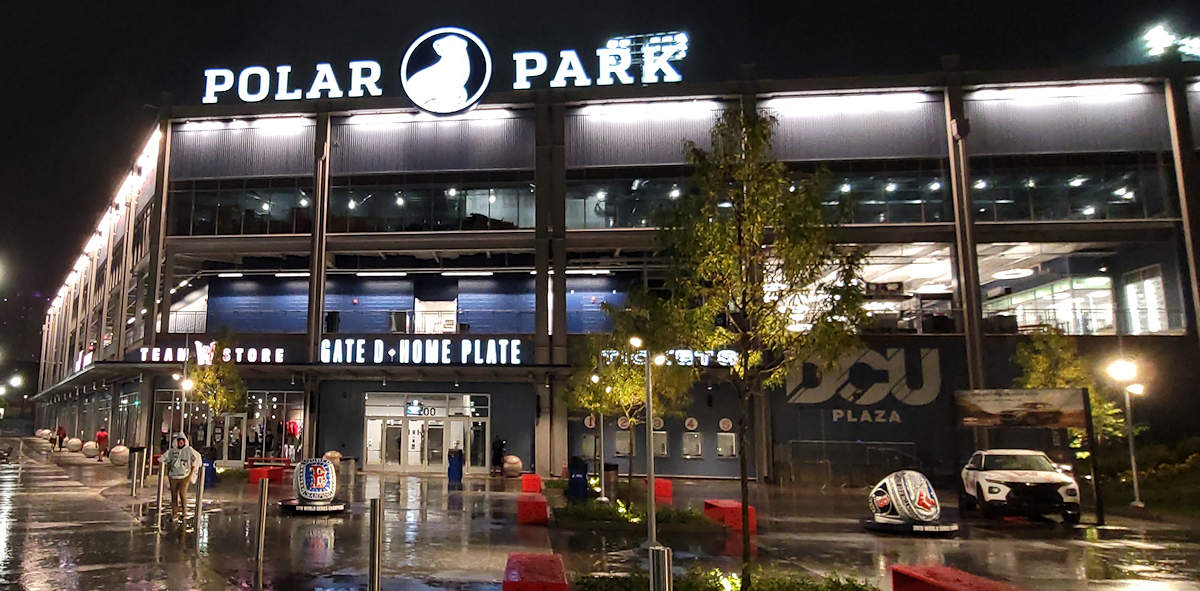
Article and photos by Joe Mock, BaseballParks.com
All rights reserved
WORCESTER, Mass. When you look at the titles Larry Lucchino has held during his career in baseball, you get a sense of the ballparks he’s impacted.
| Ballpark Stats |
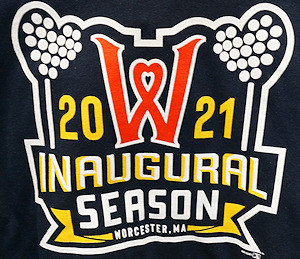 |
| Team: Worcester Red Sox of the Triple-A East League |
| First game: May 11, 2021, an 8-5 win over Syracuse |
| Capacity: 9,508, of which 6,000 are permanent seats |
| Dimensions: LF – 329; LCF – 391; CF – 402; RCF – 370; RF – 320 |
| Architect: DAIQ — Tom Martinez, Project Architect; Tommy Quirk, Lead Designer |
| Construction: Gilbane Hunt Joint Venture |
| Price: $118 million for design and construction, plus $41 million for land |
| Home dugout: 1B side |
| Field points: Northeast |
| Playing surface: Kentucky Bluegrass |
| Naming rights: Polar Beverages, headquartered in Worcester (terms not disclosed) |
| Ticket info: milb.com/worcester/tickets/ |
| Betcha didn’t know: Polar Park is located on the edge of a neighborhood known as the Canal District, even though there have been no canals there for the past 125 years. |
He’s a graduate of Princeton – where he was on the basketball team that featured Bill Bradley — and Yale Law School. He practiced law at the firm headed by Edward Bennett Williams, who at the time owned the Baltimore Orioles. Lucchino spent a lot of time dealing with the Orioles’ legal matters … so much so that he became the team’s president in 1988. During his time there, the O’s built Camden Yards, which triggered a revolution in ballpark design. “We wanted a traditional, old-fashioned ballpark in a new modern context,” he told us.
He moved onto San Diego where he became the Padres’ CEO and president in 1995. While there, the team designed Petco Park. Lucchino decided to bring together two different architects with completely different backgrounds – noted ballpark designer Joe Spear of HOK (now called Populous) and Antoine Predock, designer of some of the most beautiful museums, theaters, libraries and arts centers in the world. The result was that Petco Park is arguably the most aesthetically pleasing baseball facility ever built. “I think the single best decision we made in that process was to marry those two experienced architects,” Lucchino said.
“I just saw a survey,” he added. “It showed Petco is the prettiest ballpark in Major League Baseball. And I think that’s right.”
Then it was onto Boston, becoming the Red Sox’ CEO and president in 2002 after the group headed by John Henry purchased the team in 2001. In addition to overseeing the design and construction of the beautiful JetBlue Park in Fort Myers, he undertook a series of renovations to Fenway Park that brought the facility up to modern standards, including the Monster Seats, rooftop seating and much more. “At Fenway, it was like ten different projects. We had a different budget and different goal in mind every offseason,” he says.
During his tenure in Boston, the Red Sox notched World Series victories in 2004, 2007 and 2013, a remarkable feat for a team that hadn’t won a crown since 1918. Lucchino retired from the Red Sox’ day-to-day operations in 2015, and was inducted into the team’s Hall of Fame the following year, and deservedly so.
But his career in the National Pastime wasn’t nearly over. Before leaving the Red Sox, he tried to convince the team’s owners to purchase the Pawtucket Red Sox, Boston’s Triple-A affiliate. Instead, Lucchino said he encountered, “a little bit of capital fatigue. We’d just put several hundred million dollars into Fenway.” So the owners felt that they didn’t want to buy the Pawtucket franchise, but they “wanted it run by somebody who is hyper-friendly to us. And that became me.
“They said to me, ‘Why don’t you buy it?’”
So Lucchino organized a group of investors. In February 2015, they acquired the Pawtucket Red Sox. Their home park was McCoy Stadium, surrounded by residential neighborhoods. The park was built in 1942, and starting in 1946, it hosted affiliated Minor League baseball off and on through the decades. It’s perhaps best known for two things: the longest game in pro baseball history – 33 innings — occurred here in 1981; because the dugouts were underneath the first rows of seats, autograph seekers would lower items to be signed on strings to the players below. It was known as “fishing for autographs.”
The team commissioned a study by Pendulum to assess the viability of McCoy. The report concluded that the aging park was beyond renovating. “So we went into it with the intent of building a new ballpark in Rhode Island. We were determined to do it, but we had the misfortune of coming to the state right after the Curt Schilling situation.” In case you don’t remember, the former pitching star received $75 million in tax breaks to move a video game company he owned from Massachusetts to Providence. So Schilling did just that … and the company went belly up anyway, losing the state’s money, his own investment and laying off all 391 employees.
| Getting the band back together |
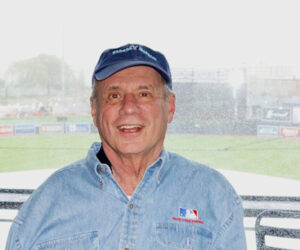 |
| When Larry Lucchino (above) needed Polar Park to be designed and built, his first thought was to get “the band back together.” Principally, that meant Charles Steinberg and Janet Marie Smith (below). |
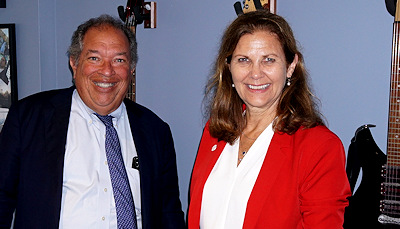 |
“We felt we had an opportunity to revitalize the team and build a new ballpark,” Lucchino recalled. “The hangover from (the Schilling situation) impeded our efforts. We learned the politics of Rhode Island were Byzantine.
“There was just a lack of vision by the leadership in Rhode Island.”
So after a couple of failed attempts to acquire land in Pawtucket and nearby Providence, the PawSox threw in the towel.
“We walked out of a difficult situation in Rhode Island and into the warm embrace of Worcester, Massachusetts,” says Lucchino. He added that the city “brought the state to the party in a way that was acceptable to the city and worked really well with us. Kudos to the elected officials and leadership of Worcester.”
He acknowledges the fans in Rhode Island weren’t the problem. “All of our efforts were to keep a team there. We just couldn’t find a partner to dance with.”
In August 2018, the PawSox announced they’d be relocating to Worcester. A new ballpark would be built there in time for the 2021 season. A potentially unpleasant lame-duck season in Pawtucket was avoided when the 2020 season was wiped out entirely.
The new ballpark needed to be designed and built. “I was not going to embark on this campaign in Worcester without getting the band back together,” Lucchino told us. “Usually wherever I’ve been, the first person I bring in is Charles Steinberg and the second is Janet Marie Smith.” Steinberg had been with Lucchino in Baltimore, San Diego and Boston, and in November 2015, he was named president of the team that would become the Worcester Red Sox. Lucchino gave Smith her first job in baseball when he hired her in 1989 (“It was the best free-agent signing the Orioles had in 1989,” he told us for an article in USA TODAY about Smith). She consulted for Lucchino on Petco Park and was responsible for all of the renovations at Fenway during his first decade with the Red Sox. And the architecture firm working with Lucchino and Smith on all of those renovations was DAIQ of Somerville, Mass. They were the ones selected by the city to design Polar Park, so consider them part of the “band” that Lucchino wanted to bring back together.
| The real McCoy |
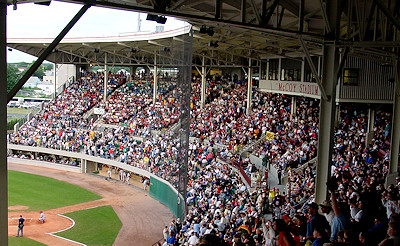 |
| When Lucchino took over the Pawtucket Red Sox, their home park was McCoy Stadium, built in 1942. A study indicated it couldn’t be renovated to bring it up to modern standards. |
The band leader, though, is Smith. “Janet’s job has always been to help us design something special and appropriate for the fans. She did an extraordinary job here in Worcester as well.” Indeed, her fingerprints are all over Polar Park, the WooSox’ new home. “There’s this simplicity and intimacy about it that are quite remarkable. We hit the key note, which was to make it look and taste and feel and smell like Worcester. To do that, you’ve got to find out what the cultural and historical elements are of the town.” And as we’ll see, you have to ask the locals what they want in the park. And take copious handwritten notes about what they tell you.
Lucchino has been impressed by local business leaders. “Before we decided to come here, we needed to determine if the business community could support us. They stood up and really came forward. They certainly punched above their weight class. The corporate community here deserves a lot of credit.
“If you look around the outfield here, you will see signage from virtually every major business in Worcester.”
The residents of Worcester have embraced the team as well. This is evident not only by the attendance, but also by “the extraordinary feedback,” says Lucchino. “The emails, word of mouth, media reviews, it’s all been excellent.”
Polar Park is a striking facility – although the jury is split on the look of the exterior – and it’s no secret that when you count the cost of the land, it’s the most expensive ballpark ever built below the Major League level. But how did it turn out? What’s near it, and what’s it like to attend a game here?
Read on for our in-depth look at Polar Park.
The Setting

He says it in a tone that is almost defiant. “Did you know Worcester is the second biggest city in New England?” Lucchino asked while being interviewed for this review. No, I definitely did not.
Obviously, Boston is the largest, but I would’ve guessed Hartford or Providence had more people. Nope. Worcester is the 139th biggest city in the U.S., while Providence isn’t far behind at 144th. Springfield’s population ranks 169th, while Hartford is 232nd.
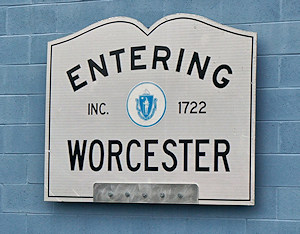
Worcester’s 2020 population was 184,570, certainly large enough to support pro baseball. Of course, the city isn’t far from Boston, as the eastern edge of Worcester is exactly 30 miles from the western city limits of Boston. And Polar Park is a 45-mile drive from Fenway … and if you’re a Red Sox prospect playing at Triple-A, it’s drive you desperately want to make.
And in case you didn’t know, “Worcester” isn’t pronounced the way it’s spelled. It’s “Woo-ster” or “Wuss-ter” (well, most of the people who actually live there say “Wis-tah”). As far as I can tell, this pronunciation is used because the English city of Worcester (and other towns that end in -cester) is pronounced that way.
Just don’t be a dolt and call it “Wor-chester.”
While it’s not an official city slogan, the nickname most often attached to the city is “The Heart of the Commonwealth,” as Massachusetts calls itself a commonwealth, not a state. It’s the “heart” part of the slogan that is important to us, because hearts abound at Polar Park. In fact, the curly official team “W” has a heart at its, well, heart.
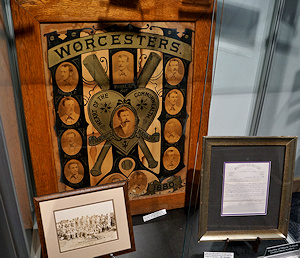 While the city hadn’t been the home to an affiliated Minor League team since 1934, there have been a lot of baseball teams here. The first was (I’m not making this up) the Worcester Worcesters. They played in the National League for three seasons starting in 1880 (see the photo from a display case on the upper level of Polar Park). Their pitcher Lee Richmond is credited with hurling the first perfect game in Major League history in June of 1880. The team was also known for hosting the lowest paid attendance in MLB history (until playing in empty stadiums became the norm recently), when only six fans paid to watch their game against Troy on September 28, 1882.
While the city hadn’t been the home to an affiliated Minor League team since 1934, there have been a lot of baseball teams here. The first was (I’m not making this up) the Worcester Worcesters. They played in the National League for three seasons starting in 1880 (see the photo from a display case on the upper level of Polar Park). Their pitcher Lee Richmond is credited with hurling the first perfect game in Major League history in June of 1880. The team was also known for hosting the lowest paid attendance in MLB history (until playing in empty stadiums became the norm recently), when only six fans paid to watch their game against Troy on September 28, 1882.
After that team’s demise, Benjamin Sumner’s book Minor League Baseball Standings lists no fewer than 16 different team names for clubs in Worcester from 1885 through 1934, although most are multiple names for the same franchise. My favorite is the Worcester Coal Heavers in the Eastern League from 1916 through 1932.
In more modern times, the city hosted the Tornadoes of the indy Can-Am League from 2005 through 2012 and the Bravehearts of the Futures Collegiate Baseball League starting in 2014 (they are still active as of this writing). Both of these teams played at the ballfield at nearby Holy Cross. Yes, that’s the college where Bob Cousy played basketball.
Before we talk about the exact location of Polar Park, I want to share a mural with you. I discovered this mural on the wall of Sail To Trail Wineworks. The winery’s Founder and CEO Chris Simpson commissioned local tattoo artist (and obviously muralist) Eamon Gillen to paint this to tell the history of Worcester.
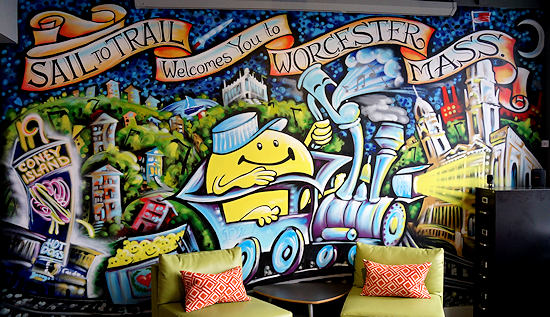
Thanks to Simpson, I now know the subtle and not-so-subtle historical elements in this mural. For instance, there’s a heart on the train car which, naturally, refers to the city’s unofficial slogan. Driving the train is a yellow smiley face, because the designer of the ubiquitous smiling yellow circle was Worcester native Harvey Ball. Another native, Robert Goddard, invented liquid-propelled rockets. City landmark Union Station is at the right of the image, and long-ago-closed mills are beyond. “Three decker” residences are shown toward the left, and hundreds of these dwellings are located in town. George’s Coney Island Hot Dogs are featured, and their stand at Polar Park’s right field is the most popular concession spot in the stadium.
And just above the train engineer’s hat is a building that we will look at more closely in the next section of this review.
Without a doubt, this is a spellbinding, ingenious telling of Worcester’s history.
Back to the present … Polar Park is located in the center of town, alongside CSX railroad tracks that are elevated atop earthen embankments. These tracks carry freight trains, AMTRAK trains and commuter trains (are there any other types of above-ground trains than these three?). Just a few hundred yards north of the park’s outfield wall, these tracks reach Union Station, whose two spires are clearly visible from the ballpark’s seating bowl.
Madison Street runs along the front of the ballpark. It goes through a tunnel under the tracks, and just 400 feet on the other side of that tunnel is George’s Coney Island, where they’ve served hot dogs since 1918. Again, they have a mega-popular stand at the ballpark … when the weather cooperates.
The area that the city had pinpointed for the ballpark — and the development that they expect to come along with the park — is on both sides of Madison, on the eastern edge of those elevated train tracks. There are several parcels of land on the southwest side of Madison waiting for development, and they are quite flat. The parcels on the northeast side of the street had a decided elevation change from street level to the back of the site.
“The city thought we would want the flat parcels across the street for the park,” explained Lucchino. “We said no thanks. We think the sloping parcel on this side of Madison would be a lot more interesting for our ballpark.”
Considering developers find flat parcels easier to build on, that gives them a lot of great options.
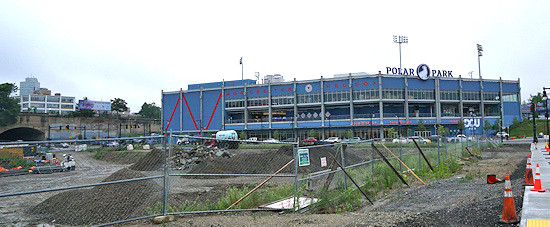 |
| There’s a lot to see in this (rainy day) photo. In the foreground is where the L-shaped hotel will be built. Between that site and the ballpark runs Madison Street. In the extreme left part of the shot, you see the tunnel where Madison runs under the elevated railroad tracks. |
On that “flat” side of the street adjacent to the tracks is Wyman Gordon, a company that makes airplane parts. This company pre-dated the ballpark, and they intend to stay right where they are. All the rest of the land to their east is being developed – and the intended uses have already been established. An L-shaped hotel will be directly across the street from the park, and behind it will be a 350-space parking garage (almost finished as of this writing) and the not-yet-started Biotech Life Science Building. Across Madison from the ballpark’s main entry plaza will be an apartment complex, possibly intended for student housing for one of Worcester’s eight colleges.
According to Denis Dowdle of Madison Properties, the developments across the street from the ballpark and in the park’s Left Field Building will top a million square feet.
That’s a lot of to-come projects, but it’s what is already in place just east of the ballpark that I find fascinating – and delicious.
This part of Worcester is called the Canal District. Will you find any canals here? No, not for the past century and a quarter. But starting in 1823, there was a series of canals and locks between Worcester and Narragansett Bay by Providence. Here there was a straight shot to the Atlantic Ocean by Newport. Interestingly, the route took boats right through Pawtucket.
This allowed the town to grow significantly in the first half of the 19th Century. At the Worcester Public Market, there is a scale model created by Americana Imagery of what the town looked like in 1834. It is worth studying (see photo at the top of this section). It is impossible to imagine that this prosperous area once looked like that maze of ponds and small farms almost two centuries ago. Commercial traffic used this waterway for only twenty years. For 40 years after that, the canals and ponds remained, finally being bricked over and built on top of in the 1890s.
The name Canal District remains, and it’s a neighborhood you need to visit. Along Green Street, just two blocks east of Polar Park, are wonderful restaurants like BirchTree (I ate here, and it was outstanding) and Smokestack Barbecue. You simply can’t miss, though, visiting Table Talk Pies. Its factory opened in 1924, and is behind a small retail shop (pre-COVID, it was a café) where they sell their regular-size pies for a ridiculously low $2 and their mini-pies (which are also sold at Polar Park) for three for a dollar. All the flavors are absolutely delicious. Don’t ask me how I know.
 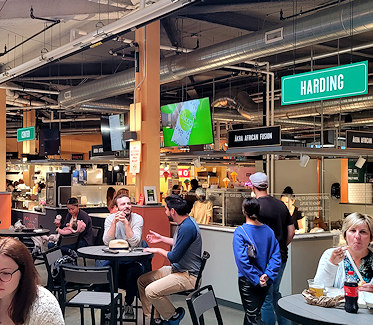 |
| There are (delicious) pies galore at Table Talk Pies. Employee Natalie Barrera was nice enough to tell us about the place’s history. The other photo shows part of the food court inside the Worcester Public Market, a must-visit spot just three blocks from Polar Park. The scale model of what the town looked like in 1834 is in this area of the Market. |
The proximity of their kitchens to right field of the ballpark makes for an interesting phenomenon. “By 3:00 each afternoon, our ballpark smells like cherry pies,” says Ben Weingarten, the team’s Ballpark Design Coordinator. “Talk about a great neighborhood we have here!”
And remember what Lucchino said about wanting the park to smell like Worcester?
To the east of Green Street are Harding Street and Water Street, and they boast even more top-notch restaurants: El Patron for Mexican; Suzette for crepes; Wings Over Worcester; a hip café called Lock 50 that serves sharable plates and a wonderful Italian restaurant where I had dinner, Russo. And there are many more.
In between Green and Harding is Worcester Public Market, which just opened in 2020. The upper floors are residential, but the ground floor is a wonderful mixture of small shops and eateries, all in the mold of an open European market. The anchor tenant is the Wachusett Brewing Company, which is next to the open food court. Eateries include Japanese, burgers, African, Italian, Mexican and more. This is a must-visit spot.
There’s one problem with this fabulous array of cuisine: parking. When I drove to the area to eat lunch on Day 2 of my rainy stay in Worcester, I drove up and down the streets and around and around the paid-parking lot by the Public Market without being able to find a space. So I gave up and went to explore another part of town. Parking is kind of a problem right by the park, too … but you can find several lots on the far side of the Madison Street tunnel in the part of town referred to as the Theater District. It’s not that long of a walk.
When I noticed that the restaurants and bars were closing at 9:00 on a Friday night, my first thought was that this certainly isn’t a “nightlife” hotspot. It was explained to me, though, that the early closings were due to staffing shortages — a national problem, to say the least — and not due to owners of these establishments thinking there wouldn’t be any business after 9:00. No, pre-COVID these places were hopping well into the night, usually staying open until 1:00 a.m. on weeknights and 2:00 on weekends. Remember, there are colleges all around this area. If the drinking and eating spots could find additional employees, they would once again stay open late.
In designing Polar Park, the proximity to all of the wonderful establishments in this dozen-block area was very much in mind. “What’s important about the Canal District is the spirit of the neighborhood,” said Smith. Plymouth Street used to extend from Green and end at the train tracks. The team has now extended it through the park’s outfield, creating a service lane and a connection to an office building currently under construction just beyond the park’s left field. Adds Smith, “Plymouth Street now connects the park to the Canal District. It knits the park into the District.”
And that’s a very good thing, because I loved everything that this neighborhood has to offer.
The Exterior
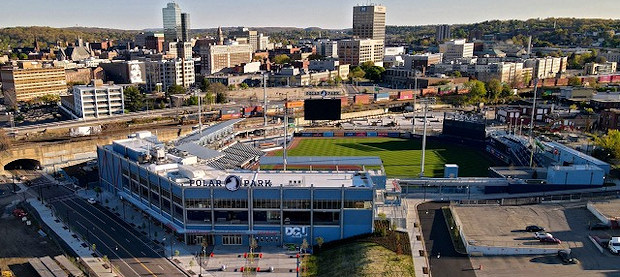
Photo above courtesy of Worcester Telegram & Gazette
On the north side of Worcester is a hill where there was once a vibrant steel fabricating plant. Along its north and east edges is a tall L-shaped building. It is called the John W. Higgins Armory. You can read about it here, but allow me to give you a brief summary of it.
Mr. Higgins built the structure to serve a couple of purposes. He wanted a building made of steel to show off the kind of work that could be done with the steel from the adjacent fabricating plant. But perhaps more than this, he wanted somewhat of a museum to hold the suits of armor he had collected over the years. The construction of the building was completed in 1931.
When I visited this structure during my time in Worcester, I intended only to take some photos of the exterior (photo below), but I ran into a friendly and helpful tattoo artist named Andrew Stanhope whose studio — called 508 Ink — is on the second level of the armory. He urged me to come inside and allow him to give me a tour of the four-story interior.
The bottom two levels are now used by a variety of small businesses, including Sail To Trail Wineworks, which has the mural mentioned in the SETTING section of this review. The top two stories, though, are like nothing I’ve ever seen in my life (other photo below). What was constructed here was meant to resemble the interior of a specific castle in Austria, where Higgins had acquired many of the suits of armor that used to be displayed here. Now it is a long, cavernous, L-shaped space that can be rented for parties, a Goth-themed wedding or the recording of a music video, if you’re looking for a good Medieval setting. Hey, it’s cheaper than going to Austria to film it.
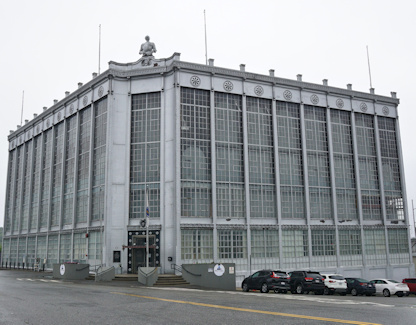 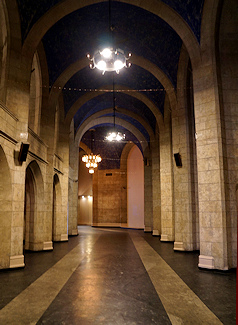 |
The “castle room” is positively creepy, and I bet I’ll be seeing it in nightmares for years to come.
“I grew up seven blocks from that Armory,” said Tommy Quirk, a Founding Partner at DAIQ. “I used to go see the suits of armor there as a kid.”
| Tour guides |
 |
| The guides for my excursion through the Higgins Armory were Chris Simpson of Sail To Trail Wineworks (left) and Andrew Stanhope of 508 Ink. Many thanks! |
Why does this matter? “When we made a presentation (about the design of the ballpark) to the city, I pointed out that Worcester was a steel town, so we should reflect the history of Worcester in the ballpark. When it was built, Higgins Armory was the tallest steel building in the country that had a glass and steel curtain-wall, and that was the look that, we felt, should inspire the exterior of the ballpark.”
And that is precisely how Polar Park was constructed, with nothing but steel and glass facing Madison Street (see the photo at the top of this section).
This hasn’t exactly been embraced by all of the baseball fans in Worcester. Part of the reason for this was that the early master-plan renderings that were released showed the exterior of the park with lots of brick, much like ballparks a century ago, as well as all of the college buildings that are scattered throughout Worcester. After all, shouldn’t a ballpark look like a ballpark?
That’s not what was done when Polar Park was actually constructed. The steel and glass of Higgins Armory was used instead. Quirk explains it this way: the Armory’s steel columns “on the exterior accentuate the height of the building with the spaces infilled by glass. The columns seem to extend, visually, above the roof by the use of decorative finials.” In case you didn’t graduate with honors from an architecture school, a finial is an ornamental feature at the very top of a column.
“Our (ballpark) design alludes to this building in the expression of the columns with the transparency of glass at the offices and street retail, and the open concourse behind,” Quirk continued. “Our columns do extend above the roof and suggest the finials of Higgins.”
| Tour guides Part II |
 |
| This was the all-star group that led me on a rainy tour around Polar Park. Standing in front of the Cap Car in left field are (from left): Ben Weingarten, WooSox; Janet Marie Smith, WooSox; Tommy Quirk, DAIQ; Sabriya Chaudhry, WooSox; D.J. Thomas, Younts Design |
He further explained that while brick made for a good, solid and inexpensive exterior for all of those local college buildings that were constructed over a century ago, that’s no longer the case. “Today, brick doesn’t bear the weight of a building. It’s really just used as a façade. Plus it’s no longer inexpensive.”
So the decision was made to use steel instead of brick.
But then there is the color chosen for the exterior: light blue. As if the steel and glass didn’t stray away enough from the classic look of a ballpark, the color seals the deal: this doesn’t look at all like a ballpark — although to be fair, Dodger Stadium has a similar color on its exterior, and it’s one of the great sports facilities ever built. And it just gets better and better, thanks to Janet Marie Smith’s upgrades.
Anyway, it’s understandable that it’s taking a little while for local fans to warm up to Polar Park’s exterior.
No one has accused it of being ugly, and I want to be clear that I don’t find it unattractive at all. It’s just not what the locals had been expecting. And the color, once you get used to it, is gorgeous when paired with the Red Sox’ dark red and dark blue, which you see plenty on the interior.
So on the street level along Madison Street (photo below), the structure has room for two retail clients closer to the train track side. I’m told that restaurants are likely tenants – all the better when the hotel is built. To the right of those spaces is the team’s merchandise store – which is wonderfully accessible to the outside world when no game is going on, but not easily accessible on gamedays to fans on the main concourse, which is two flights up.
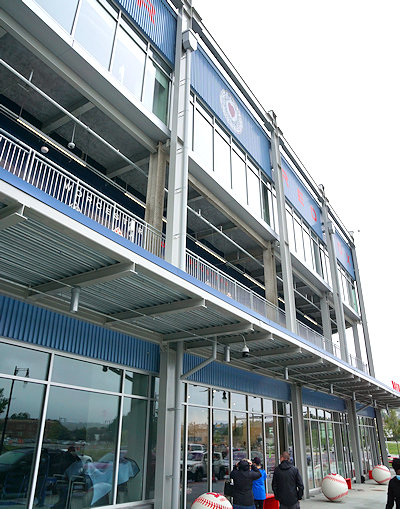 To the right of that is the main entryway for the park, as well as the ticket windows. The spacious DCU Plaza (see the photo at the very top of this page of the review) is here, where fans can meet other members of their group before entering the park. Here there are oversized World Series rings from Boston’s championships over the past two decades. “We’ve tried to have a nice balance between our Worcester identity and the relationship we have with the Boston Red Sox, which we’re really proud of,” explained Smith. “That’s why we have the World Series rings on the plaza.”
To the right of that is the main entryway for the park, as well as the ticket windows. The spacious DCU Plaza (see the photo at the very top of this page of the review) is here, where fans can meet other members of their group before entering the park. Here there are oversized World Series rings from Boston’s championships over the past two decades. “We’ve tried to have a nice balance between our Worcester identity and the relationship we have with the Boston Red Sox, which we’re really proud of,” explained Smith. “That’s why we have the World Series rings on the plaza.”
There is another entry gate (Gate C) up a hill from this plaza. This is where we need to discuss what Smith calls the “three dimensional” aspect of this site. “This was a really tight site, with quite a bit of slope to it. On Madison Street, you’re at grade. One level up, we call the Plymouth Street level (that’s the street that was extended through left field. Also note that this is the same level as the main concourse, which is 21 feet above street level). The top level is where the appropriately named Summit Street is located.” The concourse here is 30 feet above street level. There are entry gates on all three of the ballpark’s levels, while the Plymouth Street level actually has two, at opposite corners of the stadium’s footprint.
The main structure containing the seating bowl, concession stands and the upper-level lounge and suites basically wraps around the foul territory. In right field and center field, fencing separates the outside world and the inside of the park, while in left field, you have the elevated train tracks and the under-construction Left Field Building setting the park’s perimeter. Once complete, the team envisions renting space on the ground floor of that building, with the roof being used for watching WooSox games. The floors in between will be offices leased out by the developer Madison Properties, likely to life-sciences firms. As the team’s promotional video states, this building will be “a little bit Fenway, a little bit Camden and a little bit Wrigley.”
 The highest level within the park, which is in right field along Summit Street, has a great deal of construction still going on (see photo). The team hopes by September to have a series of features along this street as it heads downhill toward the center-field gate. Soon, fans will find the following, all in separate structures in stair-step fashion on the side of this hill: a ticket booth; the team’s “cap car” with ballcaps and small team merchandise for sale; a Taste of Worcester in a repurposed storage container, with a rotation of local restaurants serving their wares; a refurbished “duck boat” as used by the Boston Red Sox in their World Series parades; the Sherwood Diner; and at the top of the hill, the Wormtown Brewery.
The highest level within the park, which is in right field along Summit Street, has a great deal of construction still going on (see photo). The team hopes by September to have a series of features along this street as it heads downhill toward the center-field gate. Soon, fans will find the following, all in separate structures in stair-step fashion on the side of this hill: a ticket booth; the team’s “cap car” with ballcaps and small team merchandise for sale; a Taste of Worcester in a repurposed storage container, with a rotation of local restaurants serving their wares; a refurbished “duck boat” as used by the Boston Red Sox in their World Series parades; the Sherwood Diner; and at the top of the hill, the Wormtown Brewery.
The diner deserves special mention. Worcester is known for its diners, with a long, proud tradition of them in town. The Worcester Lunch Car and Carriage Manufacturing Company was, at one time, the largest manufacturer of diners in the world. The Sherwood Diner was one of them, and was quite popular in decades gone by. The team found its abandoned shell in Rhode Island, and is in the process of refurbishing it to its 1940s décor. When completed, food will be served there, plus it will have a small radio studio. Perhaps pregame shows can be done here. This diner is a really special touch, and is one more way that Polar Park truly is a representation of Worcester.
The slope of the ballpark’s site “certainly presented challenges to us,” noted Quirk. “We like to see these constraints as opportunities, though. It was fulfilling to be able to accomplish this. Larry (Lucchino), Janet (Marie Smith) and DAIQ were all on the same page about what we wanted to achieve. Larry kept saying that we want the ballpark to feel like a city park. With people being able to enter on any of the three levels, we think that helps achieve that.”
So does the interior of the ballpark achieve that goal? Keep reading to see our assessment of the park’s interior, and what it’s like to attend a game here.